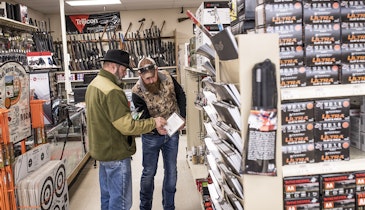When helping a customer fulfill a need for a light, it’s best to consider these factors: application, controls, size/weight and power.
Handheld lights are just that — those that you carry around.
Headlamps mount the light out of the way on your head and to a position that provides illumination where you are looking. Headlamps integrate a strap system for wear along with a battery box. More powerful lights that require more power may have the battery box at the rear of the strap assembly to better balance the light on the head.
While there is a plethora of dedicated weapon lights with integral mounts, many were initially designed as handheld lights and can also be used in that role. Others are designed specifically to use on weapons with ergonomic controls and conformal design.
Although rare, there are a couple of weapon lights on the market that provide “navigation” light, pointing downward from a soft, low-powered light with just enough illumination to allow you to see what is at your feet.
There are also helmet lights, which you may consider a hybrid of headlamps and weapon lights. Like the headlamp, it’s intended to provide illumination where you are looking. Initially, helmet lights were dedicated designs that mounted directly to the helmet itself, generally clamping along the lower edge. That was a good spot to mount the light, but often resulted in breakage as helmets are thrown around.
With the introduction of rail systems on helmets, light manufacturers have introduced lights that are designed specifically to mount to the rail sections. As those same rail systems are either Picatinny-compatible directly or through an adapter, many users use handhelds or weapon lights with a mount on helmets. Attachment accessories incorporate some form of spring-loaded grabber or bolt-in attachment to the rail. There are a multitude of attachments, but they all connect to the rail that is a set dimensional standard.
Related: 2016 Tactical Lights Buyer's Guide
Lately, we’ve seen some new light applications such as wrist lights, so you should be aware of emerging products. Additionally, a variety of accessories are available for tactical lights including filters, mounts and switch options such as remote tape switches.
Many lights incorporate special functions including pre-programmed light patterns such as S-O-S or constant strobe. The former can be used to signal for rescue, while the latter, in a bright, rapid fashion, can also be used to disorient an attacker in addition to its obvious rescue applications. Weapon lights may also incorporate lasers to help identify and designate targets.
Controls for lights include on/off, light intensity and activation of special functions. They should be ergonomic, or easy to reach and manipulate when the light is used in its intended role.
With the exception of very specialized applications, the days of incandescent light bulbs are long gone, having been replaced by Light Emitting Diodes (LEDs) that last tens of thousands of times longer and are more efficient. An LED is a semiconductor chip that converts electrical energy directly into light. Electronic control packages from various light manufacturers help intensify the light and make it last even longer. Intensification and focus of light created by the bulb are possible by a cone-shaped reflector that cradles the LED.
Depending on construction, the reflector offers either a spot- or flood-beam shape to the light. In some cases, the light will be a hybrid with a flood shape and a more intense spot focus at its center. You may find some lights incorporate a Total Internal Reflector (TIR) lens that refracts the light into a focused beam for this purpose, although this technology is not common to all lights due to its cost.
A light’s power source is important for two reasons. It is crucial to how much illumination a light provides and how long it will provide it. Power sources may be provided by a variety of disposable or rechargeable batteries, usually in AAA, AA and CR-123A sizes, or as an internal, rechargeable power cell that requires the light to be regularly attached to shore power.
Hand-in-hand with the power source is the amount of illumination a light provides. As an industry standard, you’ll see the use of lumens, which is a measurement of the total amount of light produced. However, more lumens doesn’t always necessarily mean better light. You have to consider the application. For example, high intensity lights may be too much for use in confined spaces where light bounces off of walls and blinds the user. High output also requires additional power and drains a battery more quickly. The idea is to apply the correct amount and type of light to illuminate a subject.
Another consideration for lights is waterproofness. Tactical lights aren’t dive lights, but they should be certified to at least three feet submersion (IPX8 rating) in order to offer ample waterproofness for use in all weather conditions.
To be sure, the proliferation of high quality LEDs has introduced an entire industry of low-cost tactical lights, but that doesn’t mean they all are made equally. I recently acquired a low-cost handheld light but when I turned it on, the beam had a distinct, square-shaped spot in the middle. The manufacturer didn’t do anything to refine the shape the light produced by the LED. It was distracting to the point of being unusable.
One way to differentiate the variety of brands for your customers is to determine where they were manufactured. Some will insist on Made in USA, either out of individual pride or due to agency purchasing restrictions. Naturally, American-made products are going to be more expensive. Others will be searching for a bargain.
It doesn’t just come down to cost. The real choices are about features, power and quality of manufacture. Higher end lights tend to offer comprehensive warranties. Others are disposable.
Eric Graves is the editor of the leading tactical-equipment blog Soldier Systems Daily and is a former Air Force officer. Featured image: iStock.






